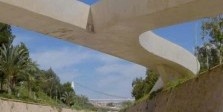A network of interlaced paths and footbridges has transformed the
bed of the Vinalopó River into a linear park that stitches together the neighbourhoods through which it passes, connecting them with natural spaces to the north of the city.
[Peter Cachola Schmal, Director of Deutsches Architekturmuseum (DAM) | Duration: 02:05]
TECHNICAL SHEET
Authors: Francisco Leiva Ivorra, Marta García Chico, Antoni Baile Jiménez, Prócoro del Real Baeza
Country: Spain
Surface: 115.000 m2
Cost: 2.382.000 €
Project: 2009
Work: 2011
End of work: 2013
DESCRIPTION
The Vinalopó River is considerably reduced when it crosses the city of Elche. Irrigation upstream and very irregular rainfall mean that water only flows in any abundance in autumn, when sudden flooding can occur. This has cut out a riverbed with steep sides, mainly as a result of landslides. In the 1970s, major channelling work put an end to flooding but also eliminated the network of paths by means of which residents on the right bank could reach the adjoining Palmeral, a vast palm grove which is inscribed in the UNESCO World Heritage List. Relegated to the condition of a marginal rubbish tip, the watercourse became a barrier that divided the city into two halves, both facing away from it.
In 2009, the City Council called for entries in a competition aimed at converting the riverbed into a three-kilometrelong linear park. The first phase of the work was completed on the upstream section where the social deterioration of the neighbourhoods and scarcity of bridges made improvement most urgent. A temporary in situ office collected data on the areas of movement that were most requested by future users. A network of paths was thus opened and led the place to be known as “The Braided Valley” because they criss-cross on both sides of the river, which were also replanted with autochthonous species of vegetation. Before reaching the walls of the channel and joining to cross the riverbed, the paths rise up in a Y-shape forming two footbridges resting on clusters of metal pillars which resemble
tree trunks and give lightness to the structure.
Before completing the first phase, the new city council stopped work on the project it had inherited but did not embrace as its own. “The Braided Valley” has not been officially opened yet, although local residents have spontaneously made it theirs. With similar spontaneity, the riverside paths and bridges disregard the orthogonal nature of the urban layout and anticipate tracks which a pedestrian’s common sense would leave on a badly situated parterre or on the ground of a snowbound city. It is to be hoped that common sense will prevail and that work on this park, which already stitches together the neighbourhoods through which it passes and connects them with natural spaces to the north of the city of Elche, will soon proceed anew.
David Bravo, architect



